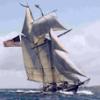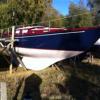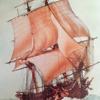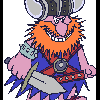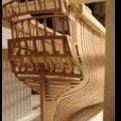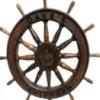MORE HANDBOOKS ARE ON THEIR WAY! We will let you know when they get here.
×
-
Posts
629 -
Joined
-
Last visited
Reputation Activity
-
 kruginmi got a reaction from Kevin in HMS Druid by Krug - FINISHED - 1:48 - Hahn
kruginmi got a reaction from Kevin in HMS Druid by Krug - FINISHED - 1:48 - Hahn
With the time available I am slowly progressing forward. An inventory of my brass supply showed I had insufficient stock for all the work I needed to do (especially when I think about scrap!). I had previously bought it pre-cut but opted to take the dive this time and buy it as a sheet and cut it as needed:
Wasn't that bad to score and snap off the strips I need. I will save a little $$ with this and feel my skills have advanced a little.
Previously when I worked with the cylinder brass I always inserted the matching rod to hold the tube in place against the strapping. Well, the next two times with silver solder the rod was welded in place as well as the cylinder. As I pondered the imponderables the obvious came to me: do not cut the cylinder to shape until after it is affixed to the strapping:
Sample fittings showed that the hull side hinge needed to be offset from the hull more than what the base strapping allowed, so another piece of brass was added. The strapping was bent to hold the new piece firm during heating and soldering, then bent afterwards back to shape. Worked like a charm.
With the new pieces attached to their rudder join part, this was put against the hull and the required attachment point was identified. I did mark where the strapping layed against the hull and once again chiseled out that area for added strength and accurate positioning. I decided to add the wood under the straps where the planking was absent.
The final shot is the bottom two rudder hinges roughed in. I need to do the same to the top hinges and then make the holes for the faux bolts. I can say the rudder is suspended on its own. It can move freely and is centered, so I am happy with the progress.
Keeping moving forward,
Mark
-
 kruginmi got a reaction from Elmer Cornish in HMS Druid by Krug - FINISHED - 1:48 - Hahn
kruginmi got a reaction from Elmer Cornish in HMS Druid by Krug - FINISHED - 1:48 - Hahn
With the time available I am slowly progressing forward. An inventory of my brass supply showed I had insufficient stock for all the work I needed to do (especially when I think about scrap!). I had previously bought it pre-cut but opted to take the dive this time and buy it as a sheet and cut it as needed:
Wasn't that bad to score and snap off the strips I need. I will save a little $$ with this and feel my skills have advanced a little.
Previously when I worked with the cylinder brass I always inserted the matching rod to hold the tube in place against the strapping. Well, the next two times with silver solder the rod was welded in place as well as the cylinder. As I pondered the imponderables the obvious came to me: do not cut the cylinder to shape until after it is affixed to the strapping:
Sample fittings showed that the hull side hinge needed to be offset from the hull more than what the base strapping allowed, so another piece of brass was added. The strapping was bent to hold the new piece firm during heating and soldering, then bent afterwards back to shape. Worked like a charm.
With the new pieces attached to their rudder join part, this was put against the hull and the required attachment point was identified. I did mark where the strapping layed against the hull and once again chiseled out that area for added strength and accurate positioning. I decided to add the wood under the straps where the planking was absent.
The final shot is the bottom two rudder hinges roughed in. I need to do the same to the top hinges and then make the holes for the faux bolts. I can say the rudder is suspended on its own. It can move freely and is centered, so I am happy with the progress.
Keeping moving forward,
Mark
-
 kruginmi got a reaction from Kevin in HMS Druid by Krug - FINISHED - 1:48 - Hahn
kruginmi got a reaction from Kevin in HMS Druid by Krug - FINISHED - 1:48 - Hahn
Slowly plugging away at the rudder as time allows. With the silver soldering finally set right I can move forward. The metal work still requires the nail holes drilled and then blackened but I am happy with them.
After soldering the three pieces together it took about an hour to slowly bend and fashion it to the correct profile. After I was satisfied (and the length was cut to its required length) I did mark its profile and chisel it in. As is seen in the pictures, the pieces stay put rather well even before glue and nails. I want to have the rudder work totally done and rock solid before I start the hull side to keep the variables to a minimum.
Still have a rear wood piece on the rudder and then eventually the tiller arm. My goal is to have the rudder basically done by the end of the weekend.
mark
-
 kruginmi got a reaction from Kevin in HMS Druid by Krug - FINISHED - 1:48 - Hahn
kruginmi got a reaction from Kevin in HMS Druid by Krug - FINISHED - 1:48 - Hahn
Thanks Brian and Lou - slow but keeping at it!
I started to blacken the metal and thought I would share my approach (this did not come easy at first!)
The process includes three containers that each metal piece goes through, acetone, blacken it (thinned) and finally water. I will not touch the piece until it has finished through the process, only with forceps.
The acetone is used to thoroughly clean the metal and is left in for 10 - 15 seconds, with some mild shaking of the container to insure no air bubbles or contact with the bottom of the container is masking some oil. Upon completion the parts are patted dry. On a side note, I get my acetone in small quantities by going to the nail polish remover aisle of the general store.
The blacken- it solution is 1 part patina, 10 parts water. Any more and the solution produces globs of black stuff that wipe off the metal and is quite messy. This was my initial mistake years ago. The green measuring cup is from a Miracle-Gro mix and is perfect - the small end for blacken-it, the large end for water. The parts generally go in for about 5 minutes or so with some mild shaking again. Again, patted dry upon completion.
The water is to wash off any blacken-it remaining then a final patting dry. The results on the top two pieces of the rudder metal work are the result of this process. Pretty straight forward one you have the right chemicals!
I have opted to hand drill the holes in the metal and other than sore fingers the going is fine. Tomorrow I hope to make some scale nails, finish the drilling, and get the metal work affixed. I am thinking about adding rudder chains so that may be a little more work.
Cheers, mark
-
 kruginmi got a reaction from Kevin in HMS Druid by Krug - FINISHED - 1:48 - Hahn
kruginmi got a reaction from Kevin in HMS Druid by Krug - FINISHED - 1:48 - Hahn
Finally - the replacement for my silver solder flux showed up in the mail today! This hobby is not just for learning things about wood! It starts that way, but then you have to branch out into all types of finished (shellacs, urethanes and all things acrylic). Just when you get comfortable, metalurgy comes to the forefront and the chemistry of soldering. My mix of supplies are:
This flux works like a charm where all others have failed.
For the gudgeons and pintles (rudder work) I needed to replicate the look with what I had available. With some thinking I opted for prototyping using some brass strips, tube and rod (that fits into the tube). On the hull side I soldered a section of tube to the brass strip on the outside facing. On the rudder side I soldered it on the inside and added a section of rod to allow the two pieces to mate.
This result is still very much in the rough for fitting to their wood sections but I believe the end result that is possible is acceptable.
Now I have to fashion the final assemblies for all the attachment points and insure I am able to drill holes through the brass sheet to allow for the nails. I am currently assuming to make an indent at the right drill locations in the brass, probably use a bit of oil for lubrication and slowly make each required hole. These will be small and I am hoping to not sacrifice too many bits. Suggestions are always appreciated.
Mark
-
 kruginmi got a reaction from Kevin in HMS Druid by Krug - FINISHED - 1:48 - Hahn
kruginmi got a reaction from Kevin in HMS Druid by Krug - FINISHED - 1:48 - Hahn
I got all the beams painted (carilngs and ledgings too) on the sides and underside but nothing photogenic so I skip the attached pic.
I did notice I had not finished the gun deck supports so I had to get a few manufactured. I dug around my odds and ends box and found the original (simple) jig I had made for those things. Wasn't too long before I had the ones required made up.
I do dowel them into the lower deck but skip this step for the top end. Just too hard to get everything aligned.
My biggest hope was to fashion the metal work for the rudder. Pulling down my supplies I found my flux had dried up to look like some meteor just fresh through the atmosphere. I could not find the stuff local and spent days and $$'s trying other stuff that just didn't work. Finally ordered the original stuff and hope to get it later this week:
Handy Flux for soldering or brazing gold, silver, brass, copper 8 oz.
Hopefully more progress to show soon,
Mark
-
 kruginmi got a reaction from harvey1847 in HMS Druid by Krug - FINISHED - 1:48 - Hahn
kruginmi got a reaction from harvey1847 in HMS Druid by Krug - FINISHED - 1:48 - Hahn
Thanks, Christian - I don't trust myself for measuring anything! Either created spacers or dividers for distances right off the plans.
Brian - I think it will be worth it. Some more of the unknown has been broken apart for the next build!
On the subject of painting, I have been steadily working around the hull giving a couple of coats. Hopefully done by the end of this weekend. I did go down memory lane, however. I needed to remove the gun deck floor to give brush access to the berth deck (the lower holds will stay as is). It had been years (literally) since this had been put in and i couldn't remember if it was glued or not. I gently worked from each end and was relieved to find it wasn't. Each carlings and ledges grouping is glued into a unit but still free from the deck beams. That floor was solid even without glue and I patted myself on the back. I ended up with a couple of boards full of pieces - NOTE TO SELF: DO NOT DROP, PUT IN SAFE PLACE, REMEMBER WHERE SAFE PLACE IS.
The berth deck as it exists today:
As is normal with Hahn plans because of the amount of flooring and visibility, there are no knees. I am sticking to this plan. A little more clean up required but this level is essentially done excepting the rudder. The rudder arm should go underneath the gun deck beams and through rigging have the lines go up the middle deck area to the steering on the top deck. (next project).
Some more memory lane items was the recovered stove. Basically cannot be seen but the stove pipe can. In keeping witht the theme of the build, it is constructed out of basswood:
You might have noticed my Krugism. When I started this build I wanted to have a distinctive feature, a feature that would readily identify this as a Krug build. You may have noticed that this hull is essentially uni-color EXCEPT the false keel. For that I used Purple Heart wood. That's right, Purple Heart. It definitely darkens with time, it is hard to see regardless, but I am thinking not too many other model ships out there will have this 'feature.'
Finally, I have started mocking up the name lettering on the stern before I attempt to carve them out of boxwood. I haven't done really any investigation on preferred font or sizing but my first guess is 'Stencil' size 20. I will ponder this some more.
Thanks for looking, comments welcome.
Mark
-
 kruginmi got a reaction from Kevin in HMS Druid by Krug - FINISHED - 1:48 - Hahn
kruginmi got a reaction from Kevin in HMS Druid by Krug - FINISHED - 1:48 - Hahn
Finally got the time to put one coat of the gel urethane on the starboard side (to include in between the frames). In the picture of the bow the location of the eking rail was left 'in the raw.' Due to lighting issues, the bow pic is a little washed out.
This wasn't that hard to apply at all. It made the frame components really pop and highlight the plank joins.
I am still looking at applying another coat. This was a good thing to do and I am glad I was pushed in this direction.
Mark
-
 kruginmi got a reaction from VonHoldinghausen in HMS Druid by Krug - FINISHED - 1:48 - Hahn
kruginmi got a reaction from VonHoldinghausen in HMS Druid by Krug - FINISHED - 1:48 - Hahn
Let's see. Banging headache (hoping it didn't go into a migraine). I did
something to my heel and it hurt to walk. Too many things to do around the
house. So....best just go to the workshop. It was the right cure because a
couple of hours later and I am feeling better (head wise) and I am reflecting on
completing the entry steps (starboard side at least).
Those items had been a little intimidating - why? I don't know. I stumbled
across some 1/32nd inch cutoff discs for my dremel (so much easier than the
1/16th inch), drew up a simple molding pattern and had it quickly cut out. I
actually found a previously cut piece of boxwood that matched the dimensions
required. Some quick scraping and cutting to equal lengths and I was ready to
glue.
I laid down some paint tape to get a straight line and cut out a spacer to
insure they match. The big question was whether the eighth step would rest on
the wales as the plans show....and yes it did.
This almost was too easy. What did I forget or mess up? Still haven't figured
it out yet (hah, hah). Pics are posted. I do laugh to see how the camera
really seems to magnify all the issues, dents and everything wrong that are
invisible otherwise.
One almost oops moment was when I as verifying the distance from the steps to the end of the waist railing - it was too short. A couple of anxious moments before I realized (so many years ago) that I had intentionally left the upper railing long to allow cutting down in the future. So, no issues. Tonight I hope to get the port side done. This will officially end the external hull work (sans the eking rail which waits until the cathead is affixed). The rudder metal work awaits.
Mark
-
 kruginmi got a reaction from albert in HMS Druid by Krug - FINISHED - 1:48 - Hahn
kruginmi got a reaction from albert in HMS Druid by Krug - FINISHED - 1:48 - Hahn
On to the chesstrees. There is definitely a few hours here as will be explained below. My first gut was to jump right in, make a cardboard template to match the hull shape, transfer to a wooden piece and get'r done. Well, I never really like butt joints that show and in this case I was unable to get a real tight fit all around the chesstree. Pause to think.....
Well, the easiest way is to inset the chesstree into the planking. So, I carefully trace around the chesstree and chisel half a plank depth away.
The result is much more satisfying. As a bonus, the joint will be a whole lot stronger.
Now here came the biggest problem to overcome, creating the sheave hole. At first I jumped in and carefully drilled a hole at both ends of the sheave hole and tried to remove any remaining wood in between. I didn't even take a picture as the result was totally unacceptable no matter how much I carefully filed, scraped and poked. I ended up walking away for the night.
Later on the solution came to me and involved keeping it as simple as possible. I would cut into the chesstree to the sheave from the bottom. Once everything was cleaned up (now that the entire hole was accessible this was easy), a small section of wood would be replaced. Very quick and the result I liked very much. The actual block you see is one fashioned quickly and will be replaced.
So overall the process was probably 3.5 hours. The next one for the port side will probably be done in less than half the time but I am okay with that. I ended up with something that looks good and methodically worked through the issues as they came up.
Cheers,
Mark
-
 kruginmi got a reaction from WackoWolf in HMS Druid by Krug - FINISHED - 1:48 - Hahn
kruginmi got a reaction from WackoWolf in HMS Druid by Krug - FINISHED - 1:48 - Hahn
Today the object was to rough in the pass through blocks, two each side. They will not be installed until the internal planking is complete (for ease of planking).
Their construction was pretty straight forward. I used 1/32" sheet basswood and cut out the box shape pieces. A basic jig was cut out to insure the inner opening was consistent both all the way through the piece, but also all four constructions. These pieces are built considerably over sized to allow for shaping and final fit later.
A small circular piece is inserted to mimic the internal block. After construction the pieces are sanded to thin out the dimensions even further. Once the position on the hull is identified and marked, the hull was drilled through at the four corners and the rest cut out. To cover any gaps upon final install, basswood is great for just injecting a little glue into the gaps and then sanding and pushing the sawdust into filling the gaps.
The inside will have additional supports glued in to insure the pieces go in and out exactly the same. A little time well spent in the shipyard.
Mark
-
 kruginmi got a reaction from daHeld in HMS Druid by Krug - FINISHED - 1:48 - Hahn
kruginmi got a reaction from daHeld in HMS Druid by Krug - FINISHED - 1:48 - Hahn
Greetings (again). Returning to MSW after a bit of off time (eg I just completed my 5th sprint triathlon). I have not been idle and have lately been kicking it into high gear with my version of the HMS Druid. Believe it or not, started in 2003 (two kids and a couple of homes ago) but looking to finish in the first quarter, 2014. I have loved every minute I have spent - probably a little over 300 hours so far.
I just finished with the bow assembly (sans the eking rail which will wait until the cathead is affixed). Previous to that was the stern caprail. I believe I am on the downhill of this build. Next up is finishing the rudder metal work and then working up from the berthdeck finishing all the details.
Additionally I have made progress on my Lady Anne and finished the DaVinci wing (currently on display at the Michigan Aviation Academy), but that will be a subject for another day.
Mark
-
 kruginmi got a reaction from Elmer Cornish in HMS Druid by Krug - FINISHED - 1:48 - Hahn
kruginmi got a reaction from Elmer Cornish in HMS Druid by Krug - FINISHED - 1:48 - Hahn
Thanks Brian and Lou - slow but keeping at it!
I started to blacken the metal and thought I would share my approach (this did not come easy at first!)
The process includes three containers that each metal piece goes through, acetone, blacken it (thinned) and finally water. I will not touch the piece until it has finished through the process, only with forceps.
The acetone is used to thoroughly clean the metal and is left in for 10 - 15 seconds, with some mild shaking of the container to insure no air bubbles or contact with the bottom of the container is masking some oil. Upon completion the parts are patted dry. On a side note, I get my acetone in small quantities by going to the nail polish remover aisle of the general store.
The blacken- it solution is 1 part patina, 10 parts water. Any more and the solution produces globs of black stuff that wipe off the metal and is quite messy. This was my initial mistake years ago. The green measuring cup is from a Miracle-Gro mix and is perfect - the small end for blacken-it, the large end for water. The parts generally go in for about 5 minutes or so with some mild shaking again. Again, patted dry upon completion.
The water is to wash off any blacken-it remaining then a final patting dry. The results on the top two pieces of the rudder metal work are the result of this process. Pretty straight forward one you have the right chemicals!
I have opted to hand drill the holes in the metal and other than sore fingers the going is fine. Tomorrow I hope to make some scale nails, finish the drilling, and get the metal work affixed. I am thinking about adding rudder chains so that may be a little more work.
Cheers, mark
-
 kruginmi got a reaction from Jeronimo in HMS Druid by Krug - FINISHED - 1:48 - Hahn
kruginmi got a reaction from Jeronimo in HMS Druid by Krug - FINISHED - 1:48 - Hahn
Thanks Brian and Lou - slow but keeping at it!
I started to blacken the metal and thought I would share my approach (this did not come easy at first!)
The process includes three containers that each metal piece goes through, acetone, blacken it (thinned) and finally water. I will not touch the piece until it has finished through the process, only with forceps.
The acetone is used to thoroughly clean the metal and is left in for 10 - 15 seconds, with some mild shaking of the container to insure no air bubbles or contact with the bottom of the container is masking some oil. Upon completion the parts are patted dry. On a side note, I get my acetone in small quantities by going to the nail polish remover aisle of the general store.
The blacken- it solution is 1 part patina, 10 parts water. Any more and the solution produces globs of black stuff that wipe off the metal and is quite messy. This was my initial mistake years ago. The green measuring cup is from a Miracle-Gro mix and is perfect - the small end for blacken-it, the large end for water. The parts generally go in for about 5 minutes or so with some mild shaking again. Again, patted dry upon completion.
The water is to wash off any blacken-it remaining then a final patting dry. The results on the top two pieces of the rudder metal work are the result of this process. Pretty straight forward one you have the right chemicals!
I have opted to hand drill the holes in the metal and other than sore fingers the going is fine. Tomorrow I hope to make some scale nails, finish the drilling, and get the metal work affixed. I am thinking about adding rudder chains so that may be a little more work.
Cheers, mark
-
 kruginmi got a reaction from catopower in HMS Druid by Krug - FINISHED - 1:48 - Hahn
kruginmi got a reaction from catopower in HMS Druid by Krug - FINISHED - 1:48 - Hahn
Slowly plugging away at the rudder as time allows. With the silver soldering finally set right I can move forward. The metal work still requires the nail holes drilled and then blackened but I am happy with them.
After soldering the three pieces together it took about an hour to slowly bend and fashion it to the correct profile. After I was satisfied (and the length was cut to its required length) I did mark its profile and chisel it in. As is seen in the pictures, the pieces stay put rather well even before glue and nails. I want to have the rudder work totally done and rock solid before I start the hull side to keep the variables to a minimum.
Still have a rear wood piece on the rudder and then eventually the tiller arm. My goal is to have the rudder basically done by the end of the weekend.
mark
-
 kruginmi got a reaction from Elmer Cornish in HMS Druid by Krug - FINISHED - 1:48 - Hahn
kruginmi got a reaction from Elmer Cornish in HMS Druid by Krug - FINISHED - 1:48 - Hahn
Finally - the replacement for my silver solder flux showed up in the mail today! This hobby is not just for learning things about wood! It starts that way, but then you have to branch out into all types of finished (shellacs, urethanes and all things acrylic). Just when you get comfortable, metalurgy comes to the forefront and the chemistry of soldering. My mix of supplies are:
This flux works like a charm where all others have failed.
For the gudgeons and pintles (rudder work) I needed to replicate the look with what I had available. With some thinking I opted for prototyping using some brass strips, tube and rod (that fits into the tube). On the hull side I soldered a section of tube to the brass strip on the outside facing. On the rudder side I soldered it on the inside and added a section of rod to allow the two pieces to mate.
This result is still very much in the rough for fitting to their wood sections but I believe the end result that is possible is acceptable.
Now I have to fashion the final assemblies for all the attachment points and insure I am able to drill holes through the brass sheet to allow for the nails. I am currently assuming to make an indent at the right drill locations in the brass, probably use a bit of oil for lubrication and slowly make each required hole. These will be small and I am hoping to not sacrifice too many bits. Suggestions are always appreciated.
Mark
-
 kruginmi got a reaction from WackoWolf in HMS Druid by Krug - FINISHED - 1:48 - Hahn
kruginmi got a reaction from WackoWolf in HMS Druid by Krug - FINISHED - 1:48 - Hahn
Thanks Rob for the vote of confidence. I am still very much a neophyte with silver soldering. It was key for me to find someone who already did it (in my case he did jewelry) and could specify exactly what equipment / supplies I needed.
Then it is practice, practice, practice. Future growth for me sees ordering more silver solder with a different melting point (I think something like 4 types available). This allows you to attach multiple pieces together without undoing any previous work. Sounds good in theory.
Still working to get those holes drilled and verify I have a path to success without destroying the rudder.
Mark
-
 kruginmi got a reaction from harvey1847 in HMS Druid by Krug - FINISHED - 1:48 - Hahn
kruginmi got a reaction from harvey1847 in HMS Druid by Krug - FINISHED - 1:48 - Hahn
Finally - the replacement for my silver solder flux showed up in the mail today! This hobby is not just for learning things about wood! It starts that way, but then you have to branch out into all types of finished (shellacs, urethanes and all things acrylic). Just when you get comfortable, metalurgy comes to the forefront and the chemistry of soldering. My mix of supplies are:
This flux works like a charm where all others have failed.
For the gudgeons and pintles (rudder work) I needed to replicate the look with what I had available. With some thinking I opted for prototyping using some brass strips, tube and rod (that fits into the tube). On the hull side I soldered a section of tube to the brass strip on the outside facing. On the rudder side I soldered it on the inside and added a section of rod to allow the two pieces to mate.
This result is still very much in the rough for fitting to their wood sections but I believe the end result that is possible is acceptable.
Now I have to fashion the final assemblies for all the attachment points and insure I am able to drill holes through the brass sheet to allow for the nails. I am currently assuming to make an indent at the right drill locations in the brass, probably use a bit of oil for lubrication and slowly make each required hole. These will be small and I am hoping to not sacrifice too many bits. Suggestions are always appreciated.
Mark
-
 kruginmi got a reaction from Dubz in HMS Druid by Krug - FINISHED - 1:48 - Hahn
kruginmi got a reaction from Dubz in HMS Druid by Krug - FINISHED - 1:48 - Hahn
Thanks, Christian - I don't trust myself for measuring anything! Either created spacers or dividers for distances right off the plans.
Brian - I think it will be worth it. Some more of the unknown has been broken apart for the next build!
On the subject of painting, I have been steadily working around the hull giving a couple of coats. Hopefully done by the end of this weekend. I did go down memory lane, however. I needed to remove the gun deck floor to give brush access to the berth deck (the lower holds will stay as is). It had been years (literally) since this had been put in and i couldn't remember if it was glued or not. I gently worked from each end and was relieved to find it wasn't. Each carlings and ledges grouping is glued into a unit but still free from the deck beams. That floor was solid even without glue and I patted myself on the back. I ended up with a couple of boards full of pieces - NOTE TO SELF: DO NOT DROP, PUT IN SAFE PLACE, REMEMBER WHERE SAFE PLACE IS.
The berth deck as it exists today:
As is normal with Hahn plans because of the amount of flooring and visibility, there are no knees. I am sticking to this plan. A little more clean up required but this level is essentially done excepting the rudder. The rudder arm should go underneath the gun deck beams and through rigging have the lines go up the middle deck area to the steering on the top deck. (next project).
Some more memory lane items was the recovered stove. Basically cannot be seen but the stove pipe can. In keeping witht the theme of the build, it is constructed out of basswood:
You might have noticed my Krugism. When I started this build I wanted to have a distinctive feature, a feature that would readily identify this as a Krug build. You may have noticed that this hull is essentially uni-color EXCEPT the false keel. For that I used Purple Heart wood. That's right, Purple Heart. It definitely darkens with time, it is hard to see regardless, but I am thinking not too many other model ships out there will have this 'feature.'
Finally, I have started mocking up the name lettering on the stern before I attempt to carve them out of boxwood. I haven't done really any investigation on preferred font or sizing but my first guess is 'Stencil' size 20. I will ponder this some more.
Thanks for looking, comments welcome.
Mark
-
 kruginmi got a reaction from SawdustDave in HMS Druid by Krug - FINISHED - 1:48 - Hahn
kruginmi got a reaction from SawdustDave in HMS Druid by Krug - FINISHED - 1:48 - Hahn
I got all the beams painted (carilngs and ledgings too) on the sides and underside but nothing photogenic so I skip the attached pic.
I did notice I had not finished the gun deck supports so I had to get a few manufactured. I dug around my odds and ends box and found the original (simple) jig I had made for those things. Wasn't too long before I had the ones required made up.
I do dowel them into the lower deck but skip this step for the top end. Just too hard to get everything aligned.
My biggest hope was to fashion the metal work for the rudder. Pulling down my supplies I found my flux had dried up to look like some meteor just fresh through the atmosphere. I could not find the stuff local and spent days and $$'s trying other stuff that just didn't work. Finally ordered the original stuff and hope to get it later this week:
Handy Flux for soldering or brazing gold, silver, brass, copper 8 oz.
Hopefully more progress to show soon,
Mark
-
 kruginmi got a reaction from mtaylor in HMS Druid by Krug - FINISHED - 1:48 - Hahn
kruginmi got a reaction from mtaylor in HMS Druid by Krug - FINISHED - 1:48 - Hahn
Thanks, Christian - I don't trust myself for measuring anything! Either created spacers or dividers for distances right off the plans.
Brian - I think it will be worth it. Some more of the unknown has been broken apart for the next build!
On the subject of painting, I have been steadily working around the hull giving a couple of coats. Hopefully done by the end of this weekend. I did go down memory lane, however. I needed to remove the gun deck floor to give brush access to the berth deck (the lower holds will stay as is). It had been years (literally) since this had been put in and i couldn't remember if it was glued or not. I gently worked from each end and was relieved to find it wasn't. Each carlings and ledges grouping is glued into a unit but still free from the deck beams. That floor was solid even without glue and I patted myself on the back. I ended up with a couple of boards full of pieces - NOTE TO SELF: DO NOT DROP, PUT IN SAFE PLACE, REMEMBER WHERE SAFE PLACE IS.
The berth deck as it exists today:
As is normal with Hahn plans because of the amount of flooring and visibility, there are no knees. I am sticking to this plan. A little more clean up required but this level is essentially done excepting the rudder. The rudder arm should go underneath the gun deck beams and through rigging have the lines go up the middle deck area to the steering on the top deck. (next project).
Some more memory lane items was the recovered stove. Basically cannot be seen but the stove pipe can. In keeping witht the theme of the build, it is constructed out of basswood:
You might have noticed my Krugism. When I started this build I wanted to have a distinctive feature, a feature that would readily identify this as a Krug build. You may have noticed that this hull is essentially uni-color EXCEPT the false keel. For that I used Purple Heart wood. That's right, Purple Heart. It definitely darkens with time, it is hard to see regardless, but I am thinking not too many other model ships out there will have this 'feature.'
Finally, I have started mocking up the name lettering on the stern before I attempt to carve them out of boxwood. I haven't done really any investigation on preferred font or sizing but my first guess is 'Stencil' size 20. I will ponder this some more.
Thanks for looking, comments welcome.
Mark
-
 kruginmi reacted to Jim Lad in HMS Druid by Krug - FINISHED - 1:48 - Hahn
kruginmi reacted to Jim Lad in HMS Druid by Krug - FINISHED - 1:48 - Hahn
Mark,
That Purpleheart false keel is an interesting trademark for your build.
I'm glad to see that I'm not the only one who has trouble remembering where the 'safe place' might be!
John
-
 kruginmi got a reaction from SailorGreg in HMS Druid by Krug - FINISHED - 1:48 - Hahn
kruginmi got a reaction from SailorGreg in HMS Druid by Krug - FINISHED - 1:48 - Hahn
Thanks, Christian - I don't trust myself for measuring anything! Either created spacers or dividers for distances right off the plans.
Brian - I think it will be worth it. Some more of the unknown has been broken apart for the next build!
On the subject of painting, I have been steadily working around the hull giving a couple of coats. Hopefully done by the end of this weekend. I did go down memory lane, however. I needed to remove the gun deck floor to give brush access to the berth deck (the lower holds will stay as is). It had been years (literally) since this had been put in and i couldn't remember if it was glued or not. I gently worked from each end and was relieved to find it wasn't. Each carlings and ledges grouping is glued into a unit but still free from the deck beams. That floor was solid even without glue and I patted myself on the back. I ended up with a couple of boards full of pieces - NOTE TO SELF: DO NOT DROP, PUT IN SAFE PLACE, REMEMBER WHERE SAFE PLACE IS.
The berth deck as it exists today:
As is normal with Hahn plans because of the amount of flooring and visibility, there are no knees. I am sticking to this plan. A little more clean up required but this level is essentially done excepting the rudder. The rudder arm should go underneath the gun deck beams and through rigging have the lines go up the middle deck area to the steering on the top deck. (next project).
Some more memory lane items was the recovered stove. Basically cannot be seen but the stove pipe can. In keeping witht the theme of the build, it is constructed out of basswood:
You might have noticed my Krugism. When I started this build I wanted to have a distinctive feature, a feature that would readily identify this as a Krug build. You may have noticed that this hull is essentially uni-color EXCEPT the false keel. For that I used Purple Heart wood. That's right, Purple Heart. It definitely darkens with time, it is hard to see regardless, but I am thinking not too many other model ships out there will have this 'feature.'
Finally, I have started mocking up the name lettering on the stern before I attempt to carve them out of boxwood. I haven't done really any investigation on preferred font or sizing but my first guess is 'Stencil' size 20. I will ponder this some more.
Thanks for looking, comments welcome.
Mark
-
 kruginmi got a reaction from SawdustDave in HMS Druid by Krug - FINISHED - 1:48 - Hahn
kruginmi got a reaction from SawdustDave in HMS Druid by Krug - FINISHED - 1:48 - Hahn
Finally got the time to put one coat of the gel urethane on the starboard side (to include in between the frames). In the picture of the bow the location of the eking rail was left 'in the raw.' Due to lighting issues, the bow pic is a little washed out.
This wasn't that hard to apply at all. It made the frame components really pop and highlight the plank joins.
I am still looking at applying another coat. This was a good thing to do and I am glad I was pushed in this direction.
Mark
-
 kruginmi got a reaction from Elmer Cornish in HMS Druid by Krug - FINISHED - 1:48 - Hahn
kruginmi got a reaction from Elmer Cornish in HMS Druid by Krug - FINISHED - 1:48 - Hahn
Finally got the time to put one coat of the gel urethane on the starboard side (to include in between the frames). In the picture of the bow the location of the eking rail was left 'in the raw.' Due to lighting issues, the bow pic is a little washed out.
This wasn't that hard to apply at all. It made the frame components really pop and highlight the plank joins.
I am still looking at applying another coat. This was a good thing to do and I am glad I was pushed in this direction.
Mark



